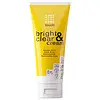What's inside
What's inside
 Key Ingredients
Key Ingredients

 Benefits
Benefits

 Concerns
Concerns

 Ingredients Side-by-side
Ingredients Side-by-side

Water
Skin ConditioningIsopropyl Palmitate
EmollientNiacinamide
SmoothingPropylene Glycol
HumectantTranexamic Acid
AstringentKojic Acid
AntioxidantAzelaic Acid
BufferingGlyceryl Stearate
EmollientPEG-100 Stearate
Dimethicone
EmollientCetearyl Alcohol
EmollientPhenoxyethanol
PreservativePolysorbate 60
EmulsifyingCetyl Alcohol
EmollientAcrylates/C10-30 Alkyl Acrylate Crosspolymer
Emulsion StabilisingGlycerin
HumectantHydroxyethyl Acrylate/Sodium Acryloyldimethyl Taurate Copolymer
Emulsion StabilisingHydroxyethyl Urea
HumectantEthylhexylglycerin
Skin ConditioningDisodium EDTA
Hydroxyethylpiperazine Ethane Sulfonic Acid
BufferingPolysorbate 20
EmulsifyingXanthan Gum
EmulsifyingSteareth-100
Gel FormingWater, Isopropyl Palmitate, Niacinamide, Propylene Glycol, Tranexamic Acid, Kojic Acid, Azelaic Acid, Glyceryl Stearate, PEG-100 Stearate, Dimethicone, Cetearyl Alcohol, Phenoxyethanol, Polysorbate 60, Cetyl Alcohol, Acrylates/C10-30 Alkyl Acrylate Crosspolymer, Glycerin, Hydroxyethyl Acrylate/Sodium Acryloyldimethyl Taurate Copolymer, Hydroxyethyl Urea, Ethylhexylglycerin, Disodium EDTA, Hydroxyethylpiperazine Ethane Sulfonic Acid, Polysorbate 20, Xanthan Gum, Steareth-100
Alternatives
Ingredients Explained
These ingredients are found in both products.
Ingredients higher up in an ingredient list are typically present in a larger amount.
Azelaic acid is a multitasker ingredient that helps treat acne, pigmentation, and irritation. It is a great option for sensitive skin.
What makes azelaic special?
The best thing about azelaic acid is it's gentleness. It's generally well-tolerated and safe to use alongside other actives like niacinamide or salicylic acid.
Unlike AHAs, azelaic acid will not make you photosensitive/sun sensitive.
You can find this ingredient naturally occurring in grains like wheat, rye, and barley. In cosmetics, azelaic acid is typically lab-made, which is more stable and effective.
Learn more about Azelaic AcidPhenoxyethanol is a preservative that has germicide, antimicrobial, and aromatic properties. Studies show that phenoxyethanol can prevent microbial growth. By itself, it has a scent that is similar to that of a rose.
It's often used in formulations along with Caprylyl Glycol to preserve the shelf life of products.
Water. It's the most common cosmetic ingredient of all. You'll usually see it at the top of ingredient lists, meaning that it makes up the largest part of the product.
So why is it so popular? Water most often acts as a solvent - this means that it helps dissolve other ingredients into the formulation.
You'll also recognize water as that liquid we all need to stay alive. If you see this, drink a glass of water. Stay hydrated!
Learn more about Water